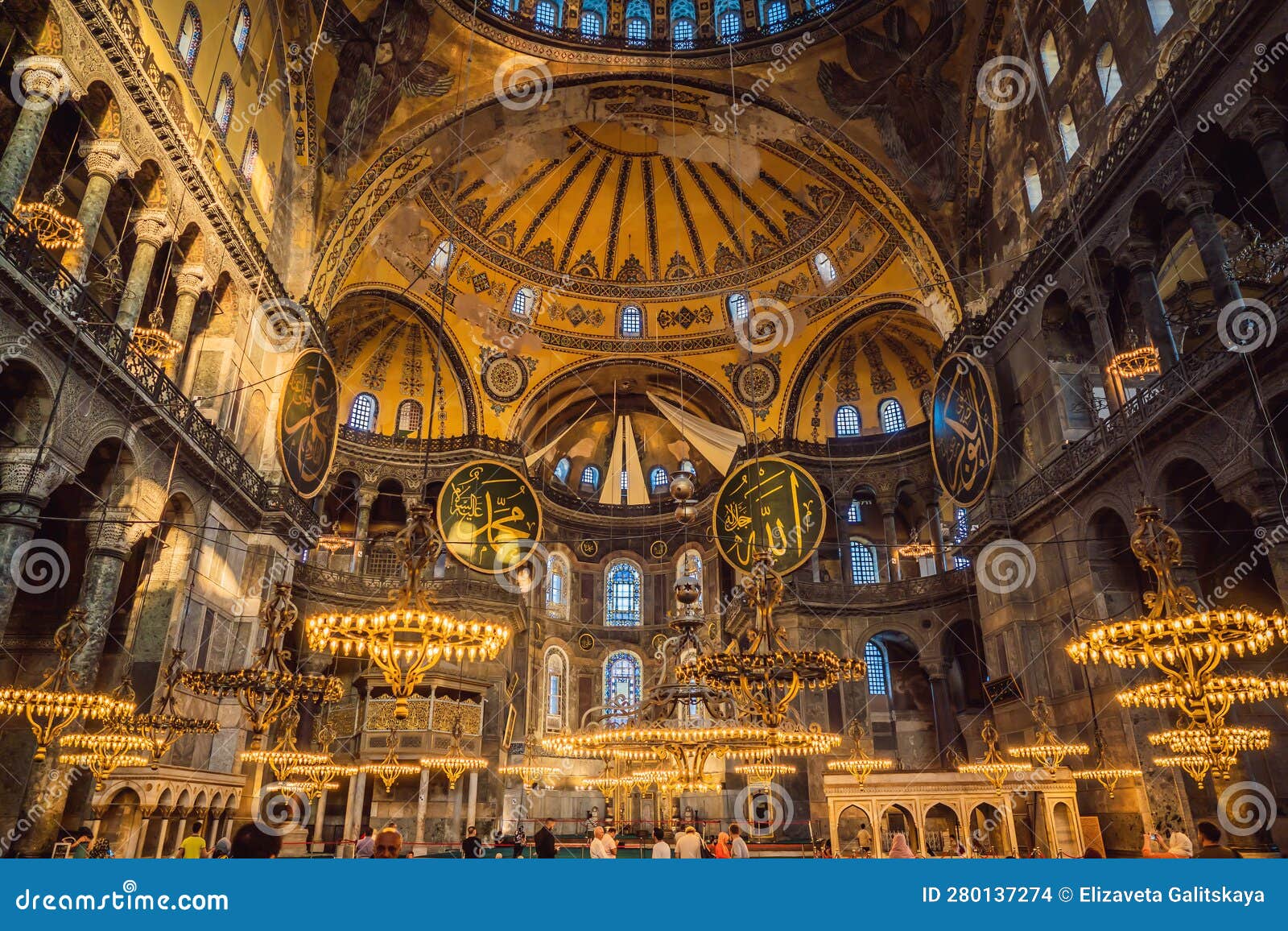Hagia Sophia: Architectural Marvel Across Empires

Table of Contents
A Byzantine Masterpiece: The Hagia Sophia's Construction and Design
Construction of the Hagia Sophia began in 532 AD under the ambitious reign of Emperor Justinian I, a pivotal moment in the Byzantine Empire. Justinian envisioned a structure that would surpass all others in grandeur and magnificence, a symbol of his power and the glory of his empire. The Hagia Sophia's design represents a pinnacle of Byzantine architecture, employing innovative techniques that were revolutionary for their time.
-
Innovative Architectural Techniques: The architects, Anthemius of Tralles and Isidore of Miletus, masterfully utilized pendentives – curved triangular supports – to transition the weight of the massive dome onto the rectangular base, a groundbreaking feat of engineering. This allowed for the creation of a vast, awe-inspiring central space. The use of lightweight materials, such as brick and mortar, further enhanced the dome's stability.
-
Key Features of Byzantine Design:
- The Grand Dome: The sheer scale and elegance of the dome, measuring approximately 107 feet in diameter, is breathtaking. Its impact on later architectural styles is undeniable, influencing dome designs across the globe for centuries.
- Mosaics: The interior was once lavishly adorned with stunning mosaics, vibrant depictions of biblical scenes and imperial figures. These mosaics held profound religious significance, serving as powerful visual aids for religious instruction and reinforcing imperial authority. Many mosaics survive, albeit with some damage and periods of concealment.
- Light and Space: The interplay of light and space within the Hagia Sophia is masterful. Sunlight streams through the large windows, illuminating the interior with a divine glow, creating a feeling of awe and reverence. This was intentionally designed to evoke a sense of the heavenly realm.
- Role in Byzantine Religious Life: The Hagia Sophia served as the central church of the Byzantine Empire, the heart of its religious life. Imperial ceremonies, religious services, and significant events all took place within its hallowed walls.
Ottoman Transformation: Hagia Sophia as a Mosque
Following the Ottoman conquest of Constantinople in 1453, the Hagia Sophia underwent a significant transformation, becoming a mosque under the rule of Sultan Mehmed II. This marked a profound shift in its function and aesthetic. While respecting the existing structure, the Ottomans added elements reflective of Islamic architecture.
-
Ottoman Modifications: The most visible changes were the addition of four minarets, slender towers from which the call to prayer (adhan) is announced, and a mihrab, a niche indicating the direction of Mecca, the holiest city in Islam. These additions subtly yet significantly altered the building's exterior profile.
-
Impact on Interior Design: The Ottomans largely preserved the existing structure but added layers of Islamic art and design. Some of the existing mosaics were covered, while others remain visible today. Calligraphy, intricate Arabic script, was added to the walls and columns, a hallmark of Islamic art and decoration. This overlay of artistic styles reflects the blending of cultures and the continuous adaptation of the Hagia Sophia throughout history. The overall aesthetic transitioned from a primarily Christian ambiance to a predominantly Islamic one, yet the underlying structure and scale of the Byzantine design remained powerfully present.
Modern Hagia Sophia: Museum to Mosque and Back Again
In the 20th century, the Hagia Sophia served as a museum, showcasing its remarkable architectural history and attracting millions of visitors from around the world. Its secular status, under the Turkish Republic, emphasized its significance as a shared cultural heritage. However, in 2020, a controversial decision reverted its status to a mosque, sparking global debate.
-
The 2020 Decision and its Aftermath: The decision to once again designate the Hagia Sophia as a mosque ignited considerable controversy, highlighting the complex interplay of religious, political, and cultural forces in modern Turkey. The debate continues to center on the balancing of religious significance with the preservation of its universal architectural and historical importance.
-
Ongoing Debates:
- Preservation of Historical Significance: Many argue for the preservation of the Hagia Sophia's architectural and historical significance as a universal symbol of human achievement, transcending religious boundaries.
- Religious Significance: The building holds profound religious meaning for both Christians and Muslims, making its designation as either a mosque or a museum a subject of intense debate.
- Impact on Tourism and Cultural Heritage: The status change has impacted tourism and the overall perception of the Hagia Sophia's role in global cultural heritage.
Architectural Influence and Legacy of Hagia Sophia
The Hagia Sophia’s design profoundly influenced subsequent architectural styles worldwide. Its massive dome, innovative use of pendentives, and masterful manipulation of light and space set new standards in engineering and aesthetics.
-
Global Impact: The Hagia Sophia's legacy is evident in countless buildings throughout history, inspiring architects and designers to push the boundaries of structural innovation and aesthetic beauty. Its influence can be seen in Renaissance churches, mosques, and even modern structures.
-
Symbol of Cultural Exchange: The Hagia Sophia stands as a unique symbol of cultural exchange and cross-cultural dialogue. Its history, reflecting the contributions of Byzantine, Ottoman, and modern Turkish cultures, showcases the power of shared heritage. Its evolution speaks to the enduring capacity of a single structure to transcend and adapt to the changing needs and beliefs of succeeding civilizations.
Conclusion:
The Hagia Sophia's remarkable journey across empires—from its creation as a Byzantine masterpiece to its transformations under Ottoman rule and its modern-day status shifts— showcases its enduring significance. Its architectural innovations, including the breathtaking dome and the innovative use of pendentives, continue to inspire awe and wonder. The Hagia Sophia's history is inextricably linked with the complex interplay of religious and political forces, highlighting the ongoing debates surrounding its cultural and religious identity. To truly grasp the magnitude of its impact, delve deeper into the Hagia Sophia history, explore its magnificent architecture through virtual tours, or, if possible, visit this breathtaking structure in person. Understanding the Hagia Sophia's rich past is key to appreciating its enduring legacy as one of the greatest architectural marvels in the world.

Featured Posts
-
 Minnesotas Compliance With Transgender Sports Ban Attorney Generals Warning
Apr 29, 2025
Minnesotas Compliance With Transgender Sports Ban Attorney Generals Warning
Apr 29, 2025 -
 Toploto Vreme I Gript Mnenie Na Prof Iva Khristova
Apr 29, 2025
Toploto Vreme I Gript Mnenie Na Prof Iva Khristova
Apr 29, 2025 -
 Capital Summertime Ball 2025 Ticket Purchase A Comprehensive Guide
Apr 29, 2025
Capital Summertime Ball 2025 Ticket Purchase A Comprehensive Guide
Apr 29, 2025 -
 Secure Your Capital Summertime Ball 2025 Tickets Braintree And Witham
Apr 29, 2025
Secure Your Capital Summertime Ball 2025 Tickets Braintree And Witham
Apr 29, 2025 -
 Canoe Awakening A Celebration Hosted By The Culture Department
Apr 29, 2025
Canoe Awakening A Celebration Hosted By The Culture Department
Apr 29, 2025
